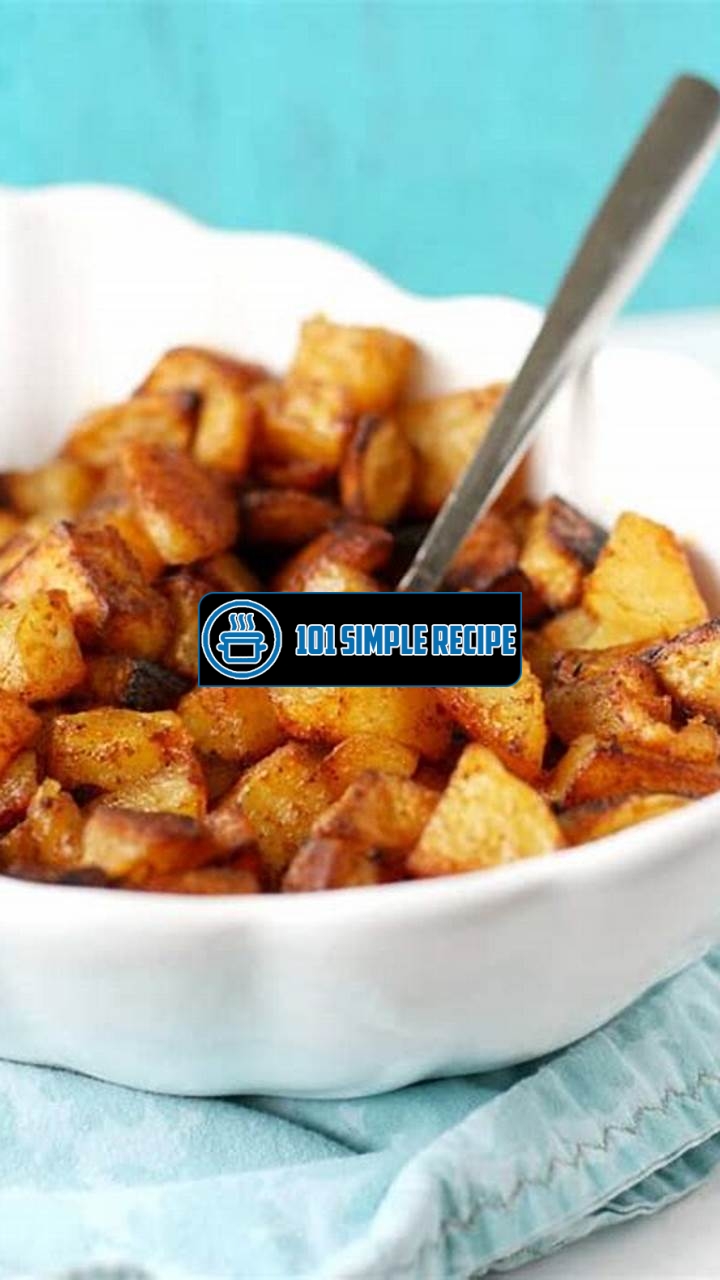Are you craving a side dish that is both crowd-pleasing and easy to prepare? Look no further than these deliciously crispy roasted potatoes, perfect for any occasion. ✨ Whether you’re hosting a dinner party, cooking a family meal, or simply looking to add some pizzazz to your weeknight dinners, these roasted potatoes are a game-changer. With their golden exterior and fluffy interior, they will satisfy your cravings and leave you wanting more. Plus, they pair well with a variety of main courses, making them a versatile addition to your culinary repertoire. So, let’s dive into the recipe and discover how to make these irresistibly crispy roasted potatoes.

The Science Behind Perfectly Seasoned Roasted Potatoes
Roasted potatoes are a classic side dish that can elevate any meal. The key to achieving the perfect combination of flavors and textures lies in understanding the science behind it. By using the right techniques and ingredients, you can create deliciously crispy roasted potatoes that will impress your guests or simply satisfy your cravings.
The Importance of Choosing the Right Potato
To achieve the best results, it is crucial to choose the right type of potato. Different varieties have different levels of starch, which affects the texture of the roasted potatoes. A high-starch potato, such as the Russet or Idaho, is ideal for achieving crispy exteriors and fluffy interiors. On the other hand, waxy potatoes like Yukon Gold or Red Bliss are better suited for creamy and firm roasted potatoes.
Additionally, the size of the potato can also impact the cooking process. Larger potatoes require more time to cook and may result in unevenly cooked roasted potatoes. It is recommended to choose potatoes of similar size to ensure even cooking.
Enhancing Flavor with Seasonings
While perfectly cooked potatoes are delicious on their own, adding the right seasonings can take them to another level. The key is to strike a balance between enhancing the natural flavors of the potatoes and adding your own unique twist.
Common seasonings for roasted potatoes include herbs like rosemary, thyme, and parsley, which add freshness and aromatic flavors. Garlic, whether minced, roasted, or in the form of garlic powder, brings a rich and savory taste. For a touch of heat, you can add cayenne pepper or paprika. Tangy flavors can be achieved by sprinkling some lemon zest or squeezing fresh lemon juice over the roasted potatoes. Remember to season generously with salt and pepper to bring out the flavor of the potatoes.
Crunchy vs. Creamy: Finding the Perfect Texture
One of the most debated aspects when it comes to roasted potatoes is the desired texture. Some prefer their potatoes to be perfectly crispy, with a golden brown exterior and a soft, fluffy interior. Others enjoy a creamier texture, where the potatoes are tender throughout.
To achieve a crunchy texture, it is important to cut the potatoes into even-sized pieces. This will ensure that they cook evenly and crisp up nicely. Tossing the potatoes in oil and baking them at a high temperature (around 400°F) will also help achieve crispiness. For a creamier texture, you can opt to roast the potatoes at a slightly lower temperature (around 375°F) for a longer time, allowing them to soften and develop a buttery consistency.
Ultimately, the perfect texture is a matter of personal preference. Experiment with different cooking times and temperatures to find the ideal balance between crunchy and creamy for your roasted potatoes.
By understanding the science behind perfectly seasoned roasted potatoes, you can take your culinary skills to the next level. Choose the right potatoes, experiment with seasonings, and find your desired texture to create a side dish that will impress every time. Whether you’re serving them alongside a Sunday roast or enjoying them as a snack, these deliciously crispy roasted potatoes are sure to be a hit!
Preparation: To Peel or Not to Peel?
When it comes to making the perfect roasted potatoes, one of the first decisions you’ll need to make is whether or not to peel your potatoes. This seemingly simple choice can have a big impact on the final result, so it’s important to consider the pros and cons before making a decision. Let’s explore the benefits of peeling your potatoes, the case for leaving the skin on, and the middle ground of partially peeled potatoes.
The Benefits of Peeling
Peeling your potatoes before roasting them can offer a number of benefits. First and foremost, it can result in a smoother and more uniform texture. By removing the skin, you eliminate any potential tough or chewy areas that could detract from the overall enjoyment of the dish. Additionally, peeling the potatoes allows for better absorption of flavors and seasonings, ensuring that each bite is perfectly seasoned.
Another advantage of peeling your potatoes is that it creates a visually appealing dish. Without the skin, the roasted potatoes have a uniform color and appearance that can be quite appealing, especially when serving guests or for special occasions. The lack of skin also means that you won’t have to worry about any unsightly black spots or blemishes on your roasted potatoes. ️
Lastly, peeling the potatoes can make the dish more accessible to those with dietary restrictions or preferences. Some individuals may have difficulty digesting the skin or simply prefer their potatoes without it. By peeling the potatoes, you can ensure that your roasted potatoes are enjoyed by a wider range of people.
The Case for Leaving the Skin On
While there are certainly benefits to peeling your potatoes, there is also a compelling case for leaving the skin on. One major advantage is the added nutrition that the skin provides. Potato skins are rich in fiber, vitamins, and minerals, including potassium and vitamin C. By keeping the skin on, you can enhance the nutritional value of your roasted potatoes.
In addition to the health benefits, leaving the skin on can add a unique and earthy flavor to the dish. The skin becomes crispy during the roasting process, adding a delightful textural contrast to the soft and fluffy interior of the potatoes. This combination of flavors and textures can elevate your roasted potatoes to a whole new level. ️
Leaving the skin on can also save you time and effort in the kitchen. Peeling potatoes can be a tedious task, especially if you’re roasting a large batch. By skipping this step, you can simplify the preparation process and get your roasted potatoes on the table faster.
The Middle Ground: Partially Peeled Potatoes
If you find yourself torn between peeling your potatoes and leaving the skin on, there is a middle ground to consider: partially peeled potatoes. This option allows you to enjoy the benefits of both worlds. By peeling some areas of the potato while leaving others intact, you can achieve a balance of smooth texture and added flavor.
Partially peeled potatoes can offer the visual appeal of roasted potatoes without any blemishes, while still retaining some of the nutritional benefits of the skin. This compromise allows for a unique and customizable dish that suits your preferences and those of your guests.
Ultimately, whether you choose to peel your potatoes or leave the skin on depends on your personal preferences and the occasion. Consider the pros and cons of each option, and don’t be afraid to experiment with different methods to find the perfect roasted potatoes for any occasion. ️✨
The Art of Seasoning
When it comes to creating deliciously crispy roasted potatoes, the art of seasoning plays a crucial role. The right combination of flavors can elevate a simple side dish into a culinary masterpiece, perfectly complementing the natural flavors of the potatoes. To achieve this, there are a few key elements that you need to consider.
Matching Seasonings to Your Tastes
The first step in seasoning your roasted potatoes is to understand your own tastes. Everyone has different preferences when it comes to flavors. Some may prefer a more subtle taste, while others enjoy bold and spicy flavors. It’s important to choose seasonings that align with your personal preferences to ensure you’ll love the final result.
You can start by thinking about the flavors you enjoy the most. Do you like a hint of garlic or rosemary? Are you a fan of smoky paprika or spicy cayenne pepper? Consider experimenting with different herbs, spices, and seasonings to find the perfect combination that tickles your taste buds.
Remember, seasoning is all about enhancing the natural flavors of the potatoes, so be mindful not to overpower them. Experiment with different amounts of seasonings until you achieve a balance that pleases your palate.
Beyond Salt and Pepper: Exploring Unique Seasoning Combinations
While salt and pepper are the go-to seasonings for many dishes, roasted potatoes offer an opportunity to explore unique flavor combinations. Don’t be afraid to think outside the box and experiment with different herbs, spices, and even condiments to add an extra layer of deliciousness to your potatoes.
Consider incorporating herbs like thyme, rosemary, or oregano for a fragrant and earthy taste. Spices such as cumin, paprika, or turmeric can add depth and complexity to the flavors. For those who enjoy a tangy twist, try drizzling your roasted potatoes with balsamic glaze or tossing them with a sprinkle of parmesan cheese.
The options are endless, and the only limit is your creativity. Take the opportunity to explore different seasoning combinations and discover unique flavors that will make your roasted potatoes truly memorable.
Mastering the Timing: When to Add Seasonings
Timing is crucial when it comes to seasoning your roasted potatoes. Adding the seasonings at the right moment will ensure that they infuse into the potatoes and create a harmonious flavor profile.
A common mistake is adding the seasonings too early, which can result in the flavors dissipating or even burning during the roasting process. To avoid this, it’s best to add the seasonings towards the end of the cooking time, when the potatoes are almost done.
This allows the seasonings to adhere to the crispy exterior of the potatoes and adds an extra layer of flavor without overpowering them. Whether you’re using dried herbs, spices, or even a drizzle of olive oil, adding them in the final few minutes of roasting will ensure that the flavors shine through.
Roasted potatoes are a versatile and delicious side dish that can be enjoyed on any occasion. By following these tips and mastering the art of seasoning, you’ll be able to create perfectly seasoned roasted potatoes that will impress your family and friends. So grab your favorite seasonings and get ready to elevate your potato game to a whole new level!
Cooking Techniques for Ultimate Deliciousness
When it comes to creating perfectly seasoned roasted potatoes that are irresistibly crispy on the outside and tender on the inside, it’s all about mastering the right cooking techniques. In this article, we will explore different methods that can take your roasted potatoes to a whole new level of flavor and crispiness. Let’s dive in!
The Classic Roasting Method
The classic roasting method is a tried-and-true technique that never fails to deliver deliciously crispy roasted potatoes. Start by preheating your oven to 425°F (220°C) to ensure a hot and consistent cooking temperature. Peel and cut your potatoes into bite-sized pieces, and then toss them with olive oil, salt, and freshly ground black pepper in a large bowl.
Pro tip: For extra flavor, add a teaspoon of garlic powder and dried herbs like rosemary or thyme to the potato mixture.
Spread the potatoes in a single layer on a baking sheet, making sure not to overcrowd them. This allows for even browning and crispiness. Roast the potatoes for about 30-40 minutes, flipping them halfway through, until they are golden brown and crispy on the outside.
Getting Creative with Infused Oils and Butter
To elevate the flavor of your roasted potatoes, consider using infused oils or flavored butter. Infused oils, such as garlic-infused olive oil or truffle-infused oil, add a delightful aroma and taste to the dish. Simply toss the potatoes with the infused oil before roasting them in the oven.
Fun fact: You can easily make your own infused oils by heating your preferred oil with your choice of flavorings, such as garlic cloves or herbs, and letting it steep for a while. Strain the oil before using it for roasting.
Flavored butter is another fantastic option to enhance the taste of your roasted potatoes. Mix softened butter with herbs, spices, or even grated Parmesan cheese, and coat the potatoes with this flavorful mixture before roasting. The result is a buttery and aromatic side dish that will impress your guests.
Try It Out: The Double Cooking Method
For those looking to achieve the ultimate level of crispy perfection, the double cooking method is a game-changer. This technique involves parboiling the potatoes before roasting them in the oven. Start by bringing a pot of salted water to a boil and add your potato chunks. Cook them for about 8-10 minutes until they are partially cooked.
✅ Good to know: Parboiling the potatoes in salted water helps to break down their starches, resulting in a fluffy interior.
Drain the parboiled potatoes and let them cool slightly. Next, transfer them to a baking sheet and drizzle with olive oil, salt, and any desired seasonings. Toss the potatoes gently to ensure they are evenly coated. Roast them in a preheated oven at 425°F (220°C) for another 25-30 minutes or until golden brown and crispy.
Pro tip: For an extra layer of crispiness, place the partially cooked potatoes in the freezer for about 15 minutes before roasting. This quick chilling process helps to achieve a delightful crunch.
To sum it up, mastering different cooking techniques is the key to achieving perfectly seasoned and crispy roasted potatoes. Whether you opt for the classic roasting method, get creative with infused oils and butter, or try the double cooking method, each technique brings its own unique flavor profile and textural excellence to the dish. So go ahead, experiment with these methods, and enjoy the mouthwatering results!
Troubleshooting Common Roasted Potato Problems
When it comes to preparing roasted potatoes, it’s not uncommon to encounter a few hiccups along the way. But fear not! With a few simple tips and tricks, you can troubleshoot common roasted potato problems and achieve perfectly seasoned spuds every time.
Avoiding Soggy Roasted Potatoes
Soggy roasted potatoes can be a real disappointment. But don’t worry, there are a few ways to ensure your potatoes come out crispy and delicious. First, make sure to dry your potatoes thoroughly before roasting. Excess moisture can lead to soggy results. Next, consider parboiling your potatoes before roasting. This helps to remove excess starch and creates a fluffier texture. Finally, make sure your oven is preheated and at the correct temperature. A hot oven will help to crisp up the potatoes and prevent them from becoming soggy.
Dealing with Uneven Cooking
Unevenly cooked roasted potatoes can be frustrating, especially when some are crispy and golden while others are still undercooked. To avoid this issue, try cutting your potatoes into similar-sized pieces. This will ensure that they cook at the same rate. Additionally, make sure that your potatoes are spread out in a single layer on the baking sheet. Overcrowding can lead to uneven cooking. Finally, consider flipping your potatoes halfway through the cooking time to ensure that they brown evenly on all sides.
Rescuing Overcooked or Burnt Potatoes
Even seasoned chefs can make the mistake of overcooking or burning their roasted potatoes. But don’t despair, there are a few tricks to salvage the situation. First, remove any burnt or overly crispy pieces from the batch. This will prevent them from imparting a bitter taste to the rest of the potatoes. Next, try tossing the remaining potatoes with a little extra oil or butter. This can help to add moisture and revive them. Finally, consider incorporating the overcooked potatoes into another dish, such as a hash or soup. This way, they won’t go to waste, and their texture can be masked by other ingredients.
In conclusion, troubleshooting common roasted potato problems is all about understanding the root causes and implementing effective solutions. By avoiding excess moisture, ensuring even cooking, and rescuing overcooked or burnt potatoes creatively, you can turn any potato mishap into a delicious success.
Frequently Asked Questions
We hope you found this article on perfectly seasoned roasted potatoes helpful. Here are some frequently asked questions:
| No. | Questions | Answers |
|---|---|---|
| 1. | How long does it take to roast potatoes? | Roasting potatoes typically takes around 40-45 minutes at 425°F (220°C). However, the exact time may vary depending on the size of the potatoes and your desired level of crispiness. |
| 2. | Do I need to peel the potatoes before roasting? | It’s up to personal preference. While you can leave the skin on for added texture and nutrients, peeling the potatoes before roasting will result in a crispier and more even texture. |
| 3. | What seasonings work well with roasted potatoes? | Popular seasonings for roasted potatoes include garlic powder, paprika, rosemary, thyme, and salt. Feel free to experiment with different combinations to find your favorite flavor profile. |
| 4. | Can I make roasted potatoes ahead of time? | Yes, you can partially roast the potatoes ahead of time and finish them off in the oven before serving. Just make sure to store them in an airtight container in the refrigerator. |
| 5. | What are some serving suggestions for roasted potatoes? | Roasted potatoes make a delicious side dish for any meal. They pair well with roasted meats, grilled vegetables, or even as a topping for salads. |
| 6. | Can I use other types of potatoes for roasting? | Yes, you can use different varieties of potatoes such as Yukon Gold, red potatoes, or fingerling potatoes for roasting. Each will provide a slightly different texture and flavor. |
Closing Remarks: Thank You for Reading!
We hope this article has inspired you to try making perfectly seasoned roasted potatoes. By following the tips and techniques mentioned, you can achieve crispy, flavorful potatoes that are sure to be a hit at any meal. Remember to experiment with different seasoning combinations to suit your taste preferences. Don’t forget to visit our website again for more delicious recipes and cooking tips. Happy cooking and enjoy your roasted potatoes!
Jump to Recipe
Perfectly Seasoned Roasted Potatoes

Learn how to make perfectly seasoned roasted potatoes that are crispy on the outside and soft on the inside. This easy recipe will be your go-to side dish for any meal.
- 4 large russet potatoes
- 2 tablespoons olive oil
- 1 teaspoon garlic powder
- 1 teaspoon paprika
- 1 teaspoon dried rosemary
- 1 teaspoon dried thyme
- Salt and pepper to taste
- Preheat the oven to 425°F (220°C).
- Wash and scrub the potatoes. Cut them into wedges or cubes, depending on your preference.
- In a bowl, combine the olive oil, garlic powder, paprika, rosemary, thyme, salt, and pepper. Toss the potatoes in the seasoning mixture, ensuring they are evenly coated.
- Spread the potatoes in a single layer on a baking sheet. Roast in the preheated oven for 40-45 minutes, or until the potatoes are golden brown and crispy.
- Remove the roasted potatoes from the oven and let them cool slightly. Serve as a delicious side dish and enjoy!






